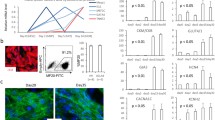Summary
The method described here to differentiate mouse embryonic stem (ES) cells into cardiomyocytes is adapted from Maltsev et al. and results in a high percentage of spontaneously beating cardiomyocyte-like cells. In order to determine to what extent the differentiating ES cells resemble true cardiomyocytes, the cells were electrophysiologically characterized during differentiation, using the whole-cell variant of the patch-clamp technique. Action potentials (APs) and membrane currents were recorded and analyzed off-line to determine electrophysiological changes during development.
Access this chapter
Tax calculation will be finalised at checkout
Purchases are for personal use only
Similar content being viewed by others
References
Magin T.M., McWhir J., Melton D.W. (1992) A new mouse embryonic stem cell line with good germ line contribution and gene targeting frequency. Nucleic Acids Research, 20, 3795–3796.
Fijnvandraat A.C., de Boer P.A.J., Lekanne Deprez R.H., Moorman A.M. (2002) Non-radioactive in situ detection of mRNA in ES cell-derived cardiomyocytes and in the developing heart. Microscopy Research and Technique, 58, 387–394.
Maltsev V., Wobus A.M., Rohwedel J., Bader M., Hescheler J. (1994) Cardiomyocytes differentiated in vitro from embryonic stem cells developmentally express cardiac-specific genes and ionic currents. Circulation Research, 75, 233–244.
Fijnvandraat A.C., van Ginneken A.C.G., de Boer P.A.J., Ruijter J.M., Christoffels V.M., Moorman A.F.M., Lekanne Deprez R.H. (2003) Cardiomyocytes derived from embryonic stem cells resemble cardiomyocytes of the embryonic heart tube. Cardiovascular Research, 58, 399–409.
Acknowledgments
We would like to thank C. Verhoek-Pockock and Dr. M.A. van Roon for their helpful suggestions.
Editor information
Rights and permissions
Copyright information
© 2007 Humana Press Inc.
About this protocol
Cite this protocol
van Ginneken, A.C.G., Fijnvandraat, A.C. (2007). Electrophysiological Properties of Embryonic Stem Cells During Differentiation Into Cardiomyocyte-Like Cell Types. In: Molnar, P., Hickman, J.J. (eds) Patch-Clamp Methods and Protocols. Methods in Molecular Biology™, vol 403. Humana Press. https://doi.org/10.1007/978-1-59745-529-9_14
Download citation
DOI: https://doi.org/10.1007/978-1-59745-529-9_14
Publisher Name: Humana Press
Print ISBN: 978-1-58829-698-6
Online ISBN: 978-1-59745-529-9
eBook Packages: Springer Protocols




